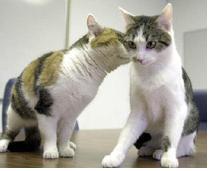In the ancient question of what determines more, heredity or the environment, the scales are now noticeably tilted to the side of the environment

Rainbow licks the ear of her clone, CC (a carbon copy) on January 8, 2003
Today you can clone your favorite cats but the clone won't behave or even look like the original. The Rainbow cat has a cotton color with brown, tan and gold spots on a white background. CC, her clone wears striped fur on a white background. Rainbow is a reserved cat, CC is a curious cat that loves to play. Rough rainbow, smooth CC.
Vin Fassel of the Humane Society might have said "I told you so". But on the other hand, its creators, at Texas A&M University, will say that it is only a little over a year old.
Her birth on December 22, 2001 was a big news because for the first time scientists were able to clone an animal from Hamath. Previous attempts to clone mammals focused on farm animals such as cows and goats.
CC's creation was funded by the Genetic Savings & Clone company, which hopes to make money from people's desire to clone their favorite animals. In February 2002, the university released details and DNA tests of the cats that showed CC was indeed a clone.
But people hoping that the clone will reproduce the animal will be discouraged, said Don Kramer, a cloning expert at A&M University. The experts say that environment is at least as important as heredity in determining a cat's personality. Getting the same DNA does not guarantee that the cats will even have the same coat pattern and certainly not the same personality. According to the opponents of cloning, there are millions of cats in shelters and on the street that are in danger and the last thing that needs to be done is a new breeding program for cats." say the opponents.
The company collected DNA samples from hundreds of cats at a price of $895 for a healthy cat and $1,395 for a sick or dead cat. Lou Hawthorne, CEO, Genetic Savings & Clone estimated that the cost of creating a clone would reach such costs. Right now the real cost is 5 times higher.
Ben Carlson, the company's spokesman, said that a year ago the company promised commercial service within a year, but now we cannot guarantee how long it will take to develop a reliable cloning technology that will give successful results.
According to him, there is a demand for cloning from dog lovers, but so far the scientists have not been able to clone a dog or another animal from his family. In fact, CC's cloning was at the request of a dog lover, not a cat lover, but they failed to clone his dog. John Sperling of the University of Phoenix sought to clone his collie mix, Missy. Unfortunately Missy died in the meantime before they could clone her.
